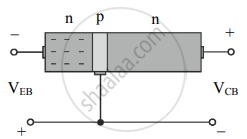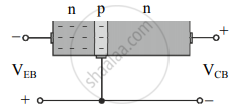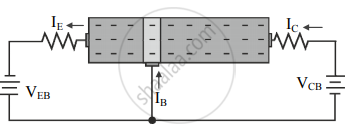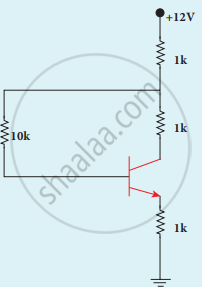Advertisements
Advertisements
Question
With the help of a neat diagram, explain the working of the npn transistor?
Solution
Working of n-p-n transistor:
- The majority of charge carriers in the emitter of the n-p-n transistor are electrons.
- A typical biasing of a transistor is shown in figure (a). In this, the emitter-base junction is forward biased while the collector-base junction is reverse biased.

Figure (a) - At the instant when the EB junction is forward biased, electrons in the emitter region have not entered the base region as shown in figure (b).

Figure (b) - When the biasing voltage VBE is greater than the barrier potential (0.6 – 0.7 V for Si transistors), many electrons enter the base region and form the emitter current IE as shown in figure (c).

Figure (c) - These electrons can either flow through the base circuit and constitute the base current (IB), or they can also flow through the collector circuit and contribute towards the collector current (IC).
- The base is thin and lightly doped, the base current is only 5% of IE.
- Electrons injected from the emitter into the base diffuse into the collector-base depletion region due to the thin base region. When the electrons enter the collector-base depletion region, they are pushed into the collector region by the electric field at the collector-base depletion region. The collector current (IC) flows through the external circuit as shown in figure (d). The collector's current IC is about 95% of IE.

Figure (d)
From the figure, we can conclude that IE = IB + IC Since the base current IB is very small we can write IC ≈ IE.
APPEARS IN
RELATED QUESTIONS
In a BJT, the largest current flow occurs ______.
In a common-base connection, the emitter current is 6.28 mA and the collector current is 6.20 mA. Determine the common-base DC current gain.
Which method of biasing is used for operating a transistor as an amplifier?
For a transistor β =75 and IE = 7.5 mA. The value of α is ______
Draw the circuit symbol for NPN and PNP transistors. What is the difference in the Emitter, Base, and Collector regions of a transistor?
Draw the circuit diagram to study the characteristic of the transistor in common emitter mode. Draw the input and output characteristics.
The principle based on which a solar cell operates is ____________.
Give the Barkhausen conditions for sustained oscillations.
Explain the current flow in an NPN transistor.
Sketch the static characteristics of a common emitter transistor and bring out the essential features of input and output characteristics.
Transistor functions as a switch. Explain.
A transistor of α = 0.99 and VBE = 0.7 V is connected in the common-emitter configuration as shown in the figure. If the transistor is in the saturation region, find the value of collector current.

If l1, l2, l3 are the lengths of the emitter, base and collector of a transistor, then ____________.
For a transistor, the current ratio 'βdc' is defined as the ratio of ______.
In the study of transistor as an amplifier, the ratio of collector current to emitter current is 0.98 then the ratio of collector current to base current will be ______.
If `alpha`-current gain of a transistor is 0.98. What is the value of `beta`- current gain of the transistor?
In an npn transistor, the base current is 100 µA and the collector current is 10 mA. The emitter current is ______.
In an npn transistor, the collector current is 24 mA. If 80% of electrons reach collector, its base current in mA is ______.
In a common emitter amplifier circuit using an n-p-n transistor, the phase difference between the input and the output voltages will be: ____________.
A transistor when connected in common emitter mode has a ____________.
The current gain `alpha` of a transistor is 0.95. The change in collector current corresponding to a change of 0.4 mA in the base current in a common emitter arrangement is ______.
For an ideal diode, the current in the following arrangement is ______.

A common emitter amplifier has a voltage gain of 50, an input impedance of 100Ω and an output impedance of 2000Ω. The power gain of the amplifier is ______.
A conducting wire has length 'L1' and diameter 'd1'. After stretching the same wire length becomes 'L2' and diameter 'd2' The ratio of resistances before and after stretching is ______.
Define peak value of alternating signal.
Explain the output characteristics of common emitter configuration of n-p-n transistor.
